CHEVROLET CAMARO 1967 1.G Chassis Workshop Manual
Manufacturer: CHEVROLET, Model Year: 1967, Model line: CAMARO, Model: CHEVROLET CAMARO 1967 1.GPages: 659, PDF Size: 114.24 MB
Page 491 of 659
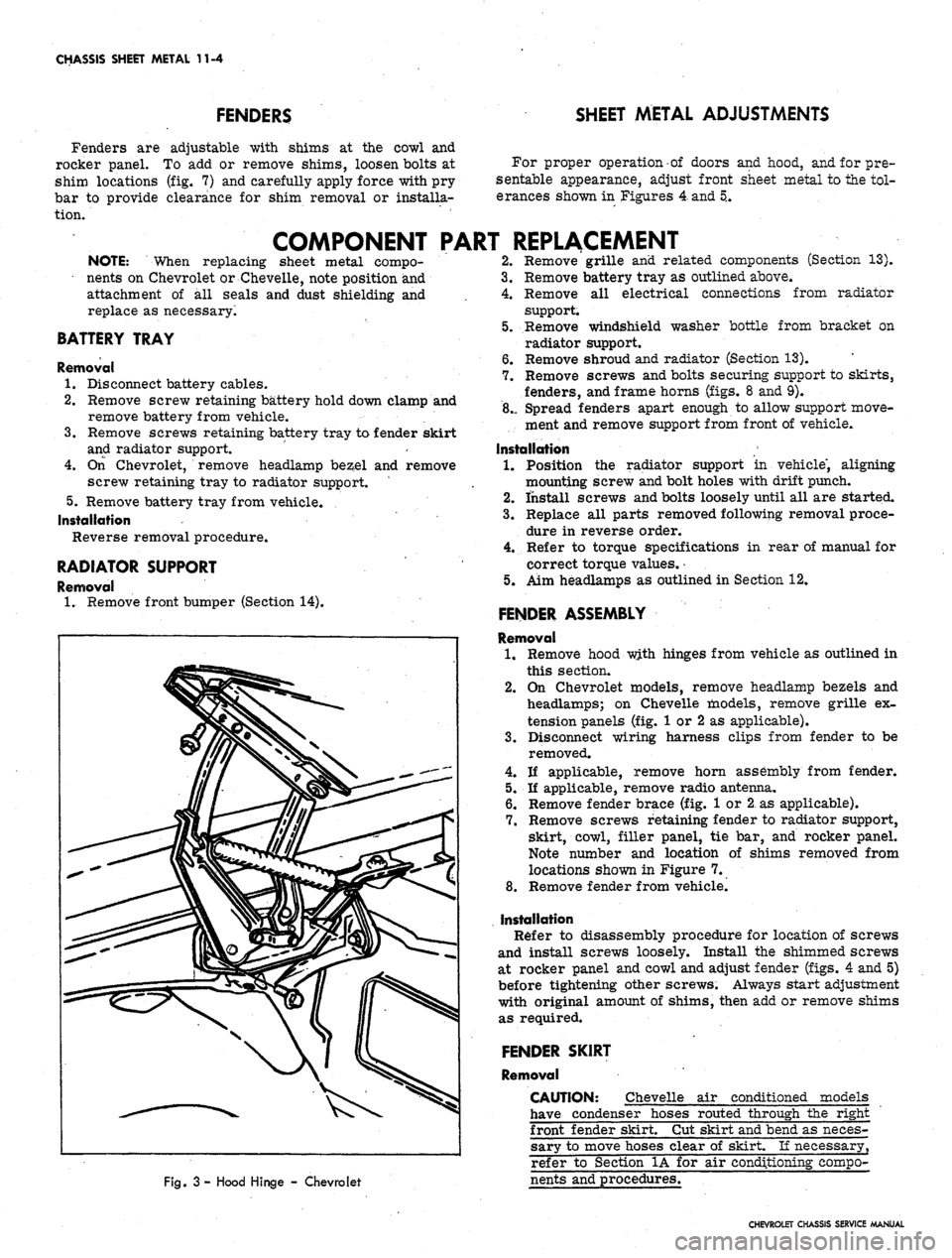
CHASSIS SHEET METAL 11-4
FENDERS
Fenders are adjustable with shims at the cowl and
rocker panel. To add or remove shims, loosen bolts at
shim locations (fig. 7) and carefully apply force with pry
bar to provide clearance for shim removal or installa-
tion.
SHEET METAL ADJUSTMENTS
For proper operation of doors and hood, and for pre-
sentable appearance, adjust front sheet metal to the tol-
erances shown in Figures
4-
and 5.
COMPONENT PART REPLACEMENT
NOTE: When replacing sheet metal compo-
nents on Chevrolet or Chevelle, note position and
attachment of all seals and dust shielding and
replace as necessary.
BATTERY TRAY
Removal
1.
Disconnect battery cables.
2.
Remove screw retaining battery hold down clamp and
remove battery from vehicle.
3.
Remove screws retaining battery tray to fender skirt
and radiator support.
4.
On Chevrolet, remove headlamp bezel and remove
screw retaining tray to radiator support.
5.
Remove battery tray from vehicle.
Installation
Reverse removal procedure.
RADIATOR SUPPORT
Removal
1.
Remove front bumper (Section 14).
Fig.
3 - Hood Hinge - Chevrolet
2.
Remove grille and related components (Section 13).
3.
Remove battery tray as outlined above.
4.
Remove all electrical connections from radiator
support.
5.
Remove windshield washer bottle from bracket on
radiator support.
6. Remove shroud and radiator (Section 13).
7.
Remove screws and bolts securing support to skirts,
fenders, and frame horns (figs. 8 and 9).
8.. Spread fenders apart enough to allow support move-
ment and remove support from front of vehicle.
Installation
1.
Position the radiator support in vehicle", aligning
mounting screw and bolt holes with drift punch.
2.
install screws and bolts loosely until all are started.
3.
Replace all parts removed following removal proce-
dure in reverse order.
4.
Refer to torque specifications in rear of manual for
correct torque values.
•
5.
Aim headlamps as outlined in Section 12.
FENDER ASSEMBLY
Removal
1.
Remove hood with hinges from vehicle as outlined in
this section.
2.
On Chevrolet models, remove headlamp bezels and
headlamps; on Chevelle models, remove grille ex-
tension panels (fig. 1 or 2 as applicable).
3.
Disconnect wiring harness clips from fender to be
removed.
4.
If applicable, remove horn assembly from fender.
5.
If applicable, remove radio antenna.
6. Remove fender brace (fig. 1 or 2 as applicable).
7.
Remove screws retaining fender to radiator support,
skirt, cowl, filler panel, tie bar, and rocker panel.
Note number and location of shims removed from
locations shown in Figure 7.
8. Remove fender from vehicle.
Installation
Refer to disassembly procedure for location of screws
and install screws loosely. Install the shimmed screws
at rocker panel and cowl and adjust fender (figs. 4 and 5)
before tightening other screws. Always start adjustment
with original amount of shims, then add or remove shims
as required.
FENDER SKIRT
Removal
CAUTION: Chevelle air conditioned models
have condenser hoses routed through the right
front fender skirt. Cut skirt and bend as neces-
sary to move hoses clear of skirt. If necessary,
refer to Section 1A for air conditioning compo-
nents and procedures.
CHEVROLET CHASSIS SERVICE MANUAL
Page 492 of 659
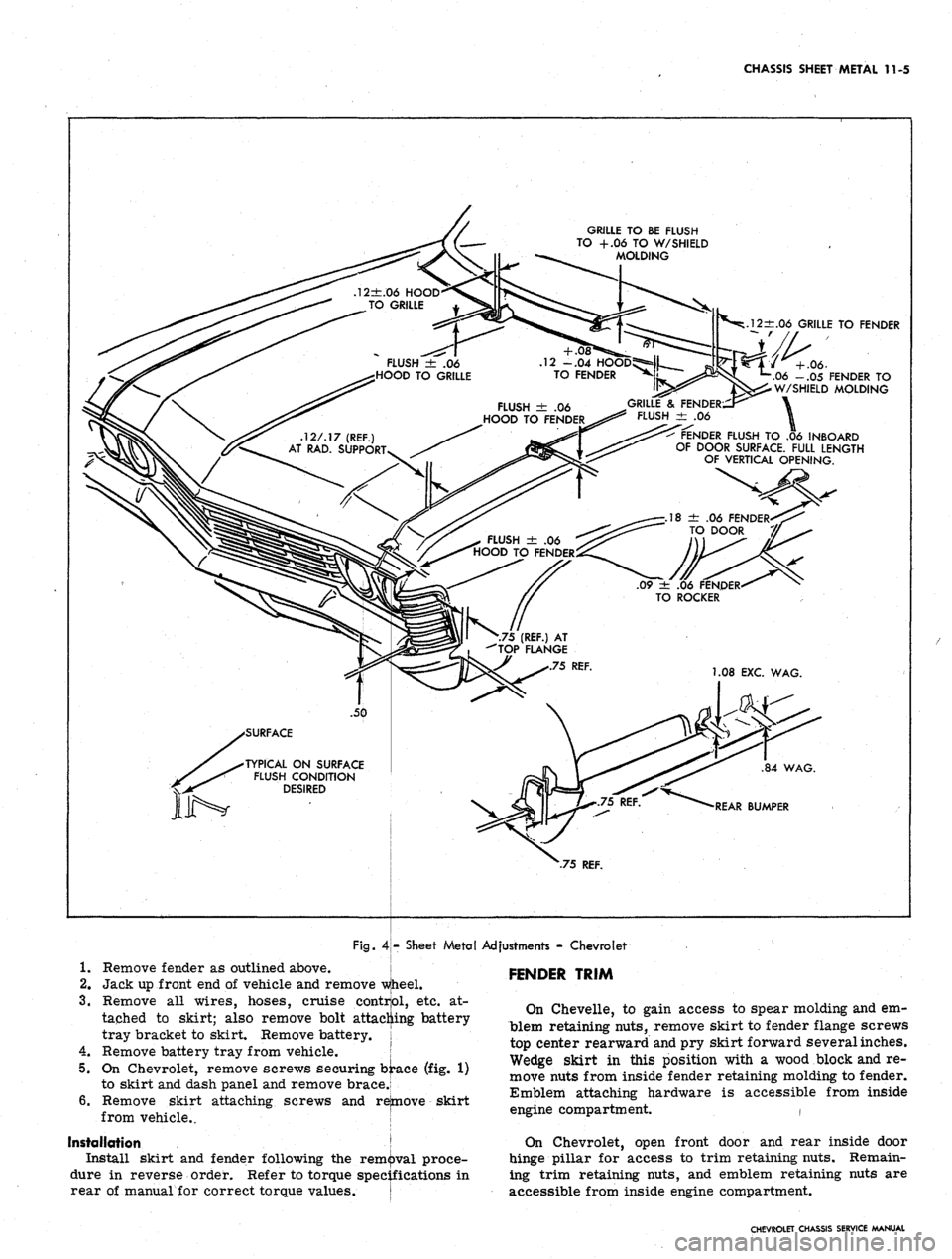
CHASSIS SHEET METAL 11-5
GRILLE TO BE FLUSH
TO +.06 TO W/SHIELD
MOLDING
±.06 GRILLE TO FENDER
.06 -.05 FENDER TO
W/SHIELD MOLDING
GRILLE"
& FENDER; ~ ~
FLUSH ± .06
FENDER FLUSH TO .06 INBOARD
OF DOOR SURFACE. FULL LENGTH
OF VERTICAL OPENING.
12±.O6 HOOD
TO GRILLE
.12 -.04
TO FENDER
FLUSH ± .06
HOOD TO GRILLE
FLUSH ± .06
HOOD TO FENDER
.12/.17 (REF.)
AT RAD. SUPPORT
.18 ± .06 FENDER
TO DOOR
FLUSH ± .06
HOOD TO FENDER
09 zfc .06 FENDER
TO ROCKER
.75 (REF.) AT
TOP FLANGE
1.08 EXC. WAG
URFACE
TYPICAL ON SURFACE
FLUSH CONDITION
DESIRED
.75 REF.
Fig.
4
- Sheet Metal Adjustments - Chevrolet
1.
Remove fender as outlined above.
2.
Jack up front end of vehicle and remove wjheel.
3.
Remove all wires, hoses, cruise control, etc. at-
tached to skirt; also remove bolt attaching battery
tray bracket to skirt. Remove battery, j
Remove battery tray from vehicle. \
5.
On Chevrolet, remove screws securing bj:ace (fig. 1)
to skirt and dash panel and remove brace.;
Remove skirt attaching screws and remove skirt
from vehicle.. !
4.
6.
Installation
j
Install skirt and fender following the removal proce-
dure in reverse order. Refer to torque specifications in
rear of manual for correct torque values. !
FENDER TRIM
On Chevelle, to gain access to spear molding and em-
blem retaining nuts, remove skirt to fender flange screws
top center rearward and pry skirt forward several inches.
Wedge skirt in this position with a wood block and re-
move nuts from inside fender retaining molding to fender.
Emblem attaching hardware is accessible from inside
engine compartment. t
On Chevrolet, open front door and rear inside door
hinge pillar for access to trim retaining nuts. Remain-
ing trim retaining nuts, and emblem retaining nuts are
accessible from inside engine compartment.
CHEVROLET CHASSIS SERVICE MANUAL
Page 493 of 659
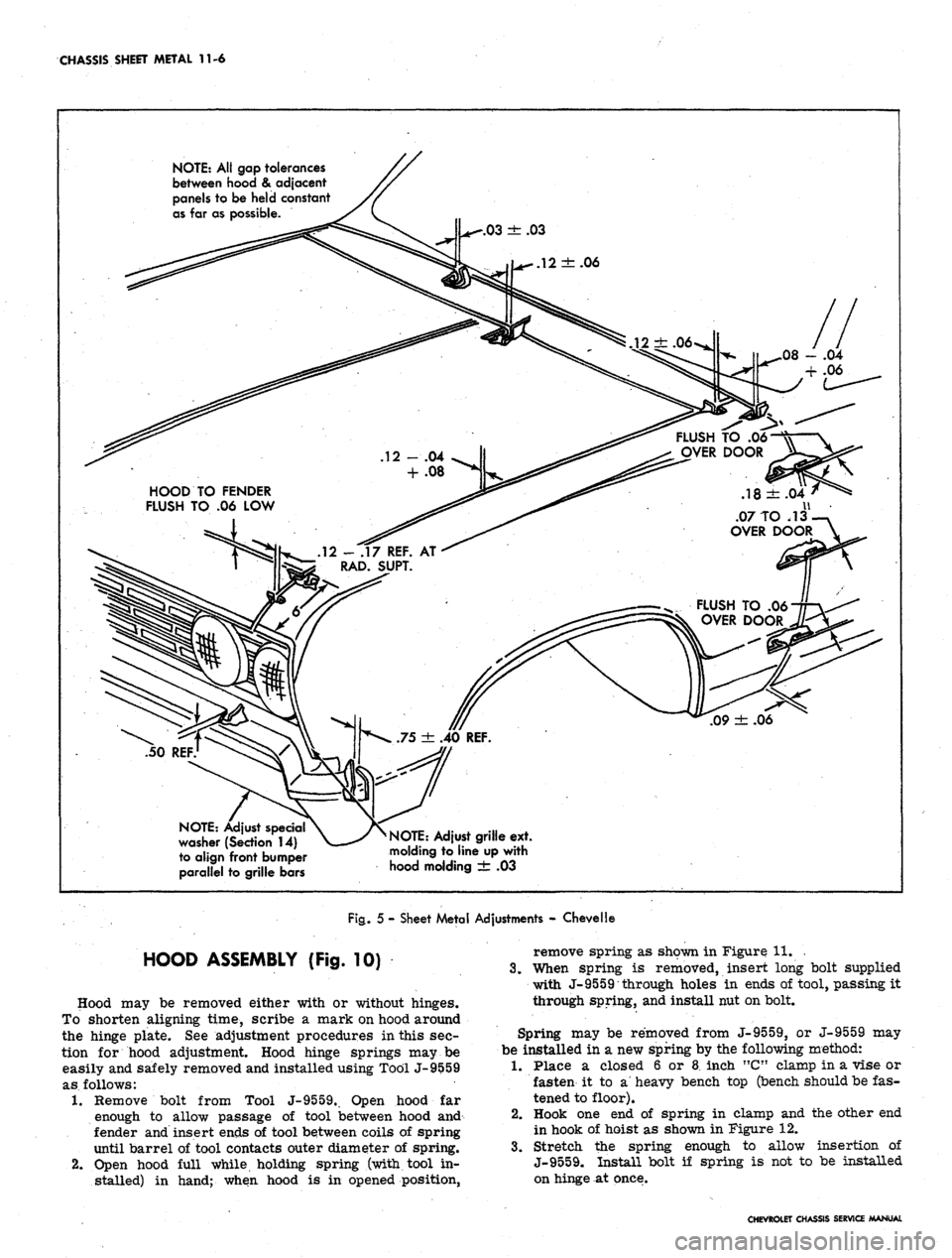
CHASSIS SHEET METAL 11-6
NOTE:
All gap tolerances
between hood & adjacent
panels to be held constant
as far as possible.
FLUSH
TO .06
OVER
DOOR
HOOD
TO
FENDER
FLUSH
TO .06 LOW
12 - .17 REF. AT
RAD.
SUPT.
.18 it .04
.07 TO J3l.
OVER
DOOR
FLUSH
TO .06
OVER
DOOR
X
.09 ± .06
.75
± .40 REF.
NOTE:
washer (Section 14)
to align front bumper
parallel to grille bars
NOTE:
Adjust grille ext.
molding to line up with
hood molding ± .03
Fig.
5 - Sheet Metal Adjustments - Chevelle
HOOD ASSEMBLY (Fig. 10)
Hood may be removed either with or without hinges.
To shorten aligning time, scribe a mark on hood around
the hinge plate. See adjustment procedures in this sec-
tion for hood adjustment. Hood hinge springs may be
easily and safely removed and installed using Tool J-9559
as follows:
1.
Remove bolt from Tool J-9559.. Open hood far
enough to allow passage of tool between hood and
fender and insert encls of tool between coils of spring
until barrel of tool contacts outer diameter of spring.
2.
Open hood full while holding spring (with tool in-
stalled) in hand; when hood is in opened position,
remove spring as shown in Figure 11. .
3.
When spring is removed, insert long bolt supplied
with J-9559 through holes in ends of tool, passing it
through spring, and install nut on bolt.
Spring may be removed from J-9559, or J-9559 may
be installed in a new spring by the following method:
1.
Place a closed 6. or 8. inch "CTt clamp in a vise or
fasten it to a' heavy bench top (bench should be fas-
tened to floor).
2.
Hook one end of spring in clamp and the other end
in hook of hoist as shown in Figure 12.
3.
Stretch the spring enough to allow insertion of
J-9559. Install bolt if spring is not to be installed
on hinge at once.
CHEVROLET CHASSIS SERVICE MANUAL
Page 494 of 659
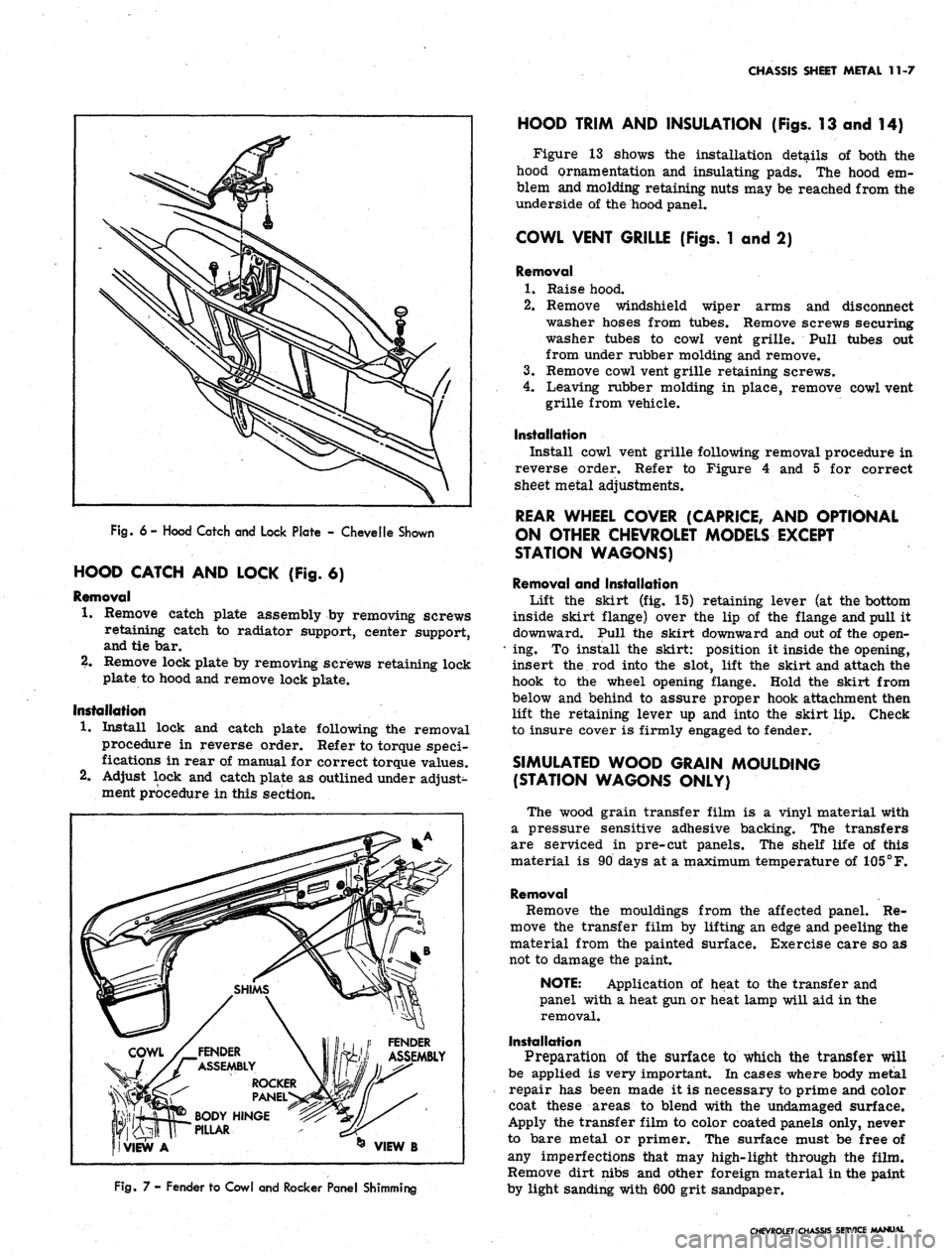
CHASSIS SHEET METAL 11-7
Fig.
6 - Hood Catch and Lock Plate - Chevelle Shown
HOOD CATCH AND LOCK {Fig. 6)
Removal
1.
Remove catch plate assembly by removing screws
retaining catch to radiator support, center support,
and tie bar.
2.
Remove lock plate by removing screws retaining lock
plate to hood and remove lock plate.
Installation
1.
Install lock and catch plate following the removal
procedure in reverse order. Refer to torque speci-
fications in rear of manual for correct torque values.
2.
Adjust lock and catch plate as outlined under adjust^
ment procedure in this section.
FENDER
ASSEMBLY
ROCKER
PANEL
BODY HINGE
PILLAR
VIEW B
Fig.
7 - Fender to Cowl and Rocker Panel Shimming
HOOD TRIM AND INSULATION (Figs. 13 and 14)
Figure 13 shows the installation details of both the
hood ornamentation and insulating pads. The hood em-
blem and molding retaining nuts may be reached from the
underside of the hood panel.
COWL VENT GRILLE (Figs. 1 and 2)
Removal
1.
Raise hood.
2.
Remove windshield wiper arms and disconnect
washer hoses from tubes. Remove screws securing
washer tubes to cowl vent grille. Pull tubes out
from under rubber molding and remove.
3.
Remove cowl vent grille retaining screws.
4.
Leaving rubber molding in place, remove cowl vent
grille from vehicle.
Installation
Install cowl vent grille following removal procedure in
reverse order. Refer to Figure 4 and 5 for correct
sheet metal adjustments.
REAR WHEEL COVER (CAPRICE, AND OPTIONAL
ON OTHER CHEVROLET MODELS EXCEPT
STATION WAGONS)
Removal and Installation
Lift the skirt (fig. 15) retaining lever (at the bottom
inside skirt flange) over the lip of the flange and pull it
downward. Pull the skirt downward and out of the open-
*
ing. To install the skirt: position it inside the opening,
insert the rod into the slot, lift the skirt and attach the
hook to the wheel opening flange. Hold the skirt from
below and behind to assure proper hook attachment then
lift the retaining lever up and into the skirt lip. Check
to insure cover is firmly engaged to fender.
SIMULATED WOOD GRAIN MOULDING
(STATION WAGONS ONLY)
The wood grain transfer film is a vinyl material with
a pressure sensitive adhesive backing. The transfers
are serviced in pre-cut panels. The shelf life of this
material is 90 days at a maximum temperature of
105°
F.
Removal
Remove the mouldings from the affected panel. Re-
move the transfer film by lifting an edge and peeling the
material from the painted surface. Exercise care so as
not to damage the paint.
NOTE: Application of heat to the transfer and
panel with a heat gun or heat lamp will aid in the
removal.
Installation
Preparation of the surface to which the transfer will
be applied is very important. In cases where body metal
repair has been made it is necessary to prime and color
coat these areas to blend with the undamaged surface.
Apply the transfer film to color coated panels only, never
to bare metal or primer. The surface must be free of
any imperfections that may high-light through the film.
Remove dirt nibs and other foreign material in the paint
by light sanding with 600 grit sandpaper.
CHEVROLET CHASSIS SERVICE MANUAL
Page 495 of 659
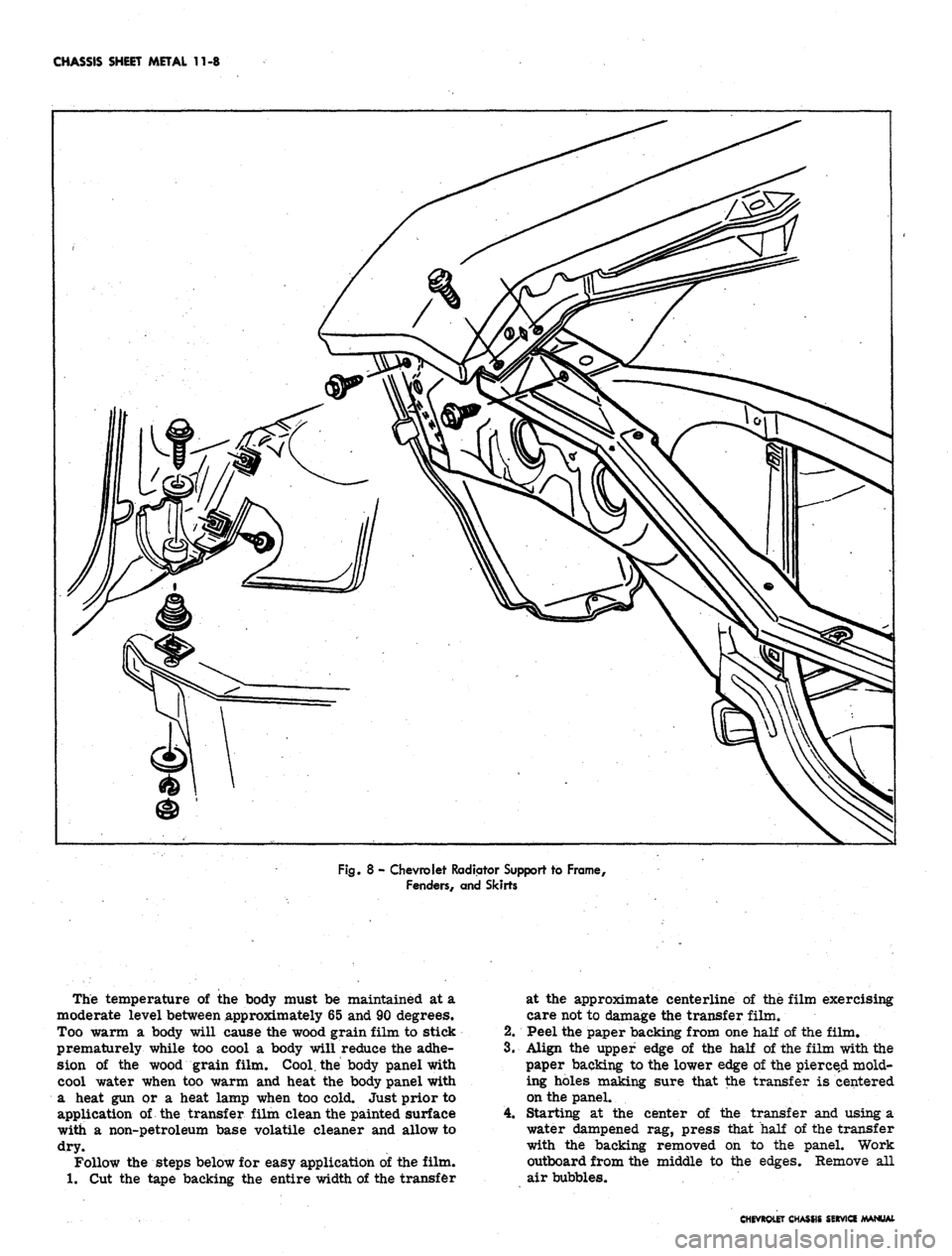
CHASSIS SHEET METAL 11-8
Fig.
8 - Chevrolet Radiator Support to Frame,
Fenders, and Skirts
The temperature of the body must be maintained at a
moderate level between approximately 65 and 90 degrees.
Too warm a body will cause the wood grain film to stick
prematurely while too cool a body will reduce the adhe-
sion of the wood grain film. Cool, the body panel with
cool water when too warm and heat the body panel with
a heat gun or a heat lamp when too cold. Just prior to
application of the transfer film clean the painted surface
with a non-petroleum base volatile cleaner and allow to
dry.
Follow the steps below for easy application of the film.
1.
Cut the tape backing the entire width of the transfer
at the approximate centerline of the film exercising
care not to damage the transfer film.
2.
Peel the paper backing from one half of the film.
3.
Align the upper edge of the half of the film with the
paper backing to the lower edge of the pierced mold-
ing holes making sure that the transfer is centered
on the panel.
4.
Starting at the center of the transfer and using a
water dampened rag, press that half of the transfer
with the backing removed on to the panel. Work
outboard from the middle to the edges. Remove all
air bubbles.
CHEVROLET CHASSIS SEKV1CE MANUAL
Page 496 of 659

CHASSIS SHEET METAL 11-9
Fig.
9 - Chevelle Radiator Support to Frame,
Fenders, and Skirts
Fig.
10 - Hood Replacement
NOTE:
The transfer can be pulled back from
the panel and reinstalled if large air pockets
develop. Exercise care not to stretch the ma-
terial. Small air bubbles may be removed by
piercing the film at the bubble with a pin and
pressing the bubble down.
5. Remove the backing from the other half of the trans-
fer. Apply this half in the same manner working
from the center to the end and from the middle to
the upper and lower edges.
6. Fold the transfer over the door or quarter edges and
press to the hemming flanges. Application of heat
with a heat lamp or heat gun will aid in folding the
transfer over the edge.
NOTE:
If the transfer film will not adhere to
the flange, brush a clear vinyl adhesive to the
back edge of the film and reapply.
7. Install the moldings.
CHEVROLET CHASSIS SERVICE MANUAL
Page 497 of 659
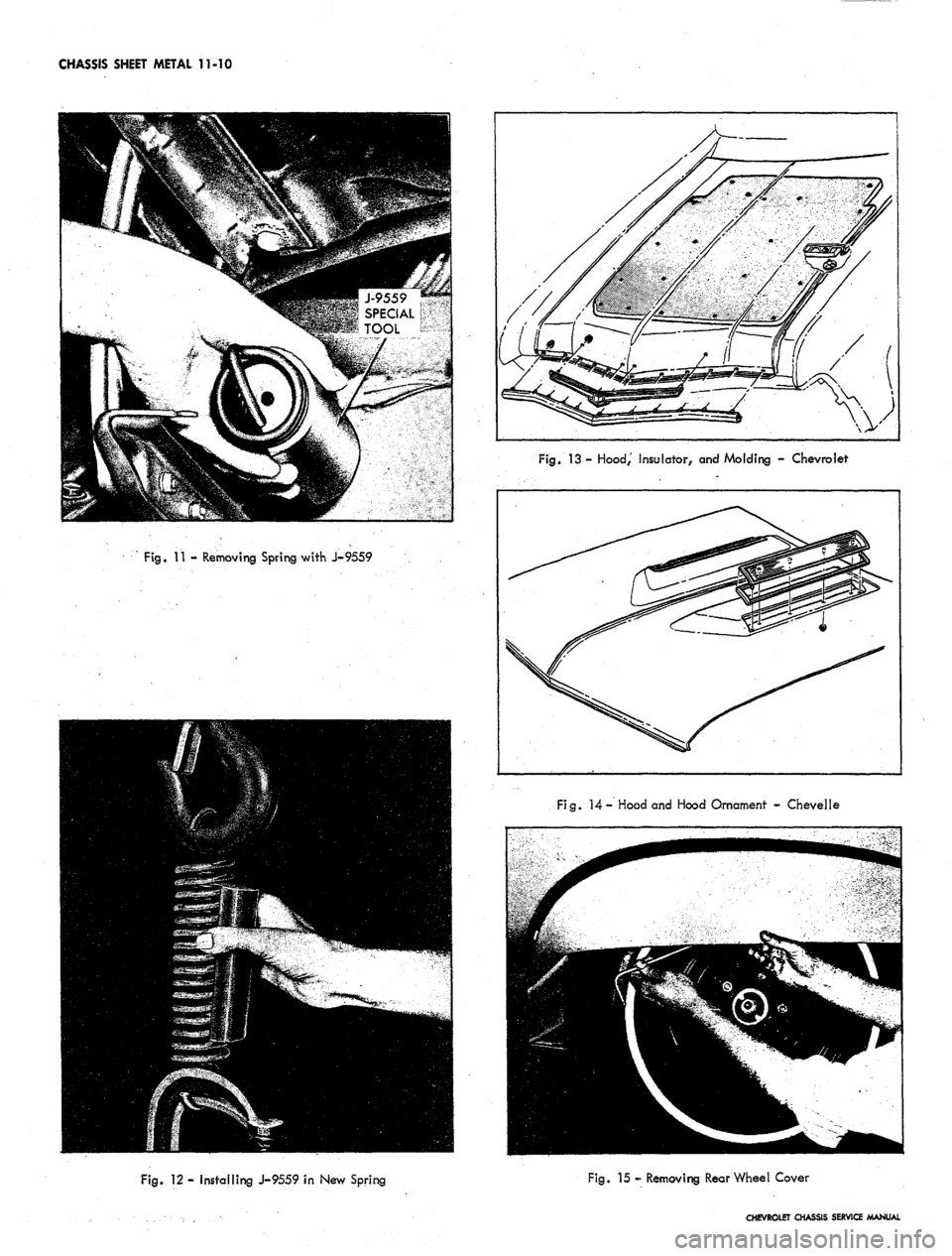
CHASSIS SHEET METAL 11-10
Fig.
11 - Removing Spring with J-9559
Fig.
13- Hood,' Insulator, and Molding - Chevrolet
Fig.
14- Hood and Hood Ornament - Chevelle
Fig.
12 - Installing J-9559 in New Spring
Fig.
15 - Removing Rear Wheel Cover
CHEVROLET CHASSIS SERVICE MANUAL
Page 498 of 659
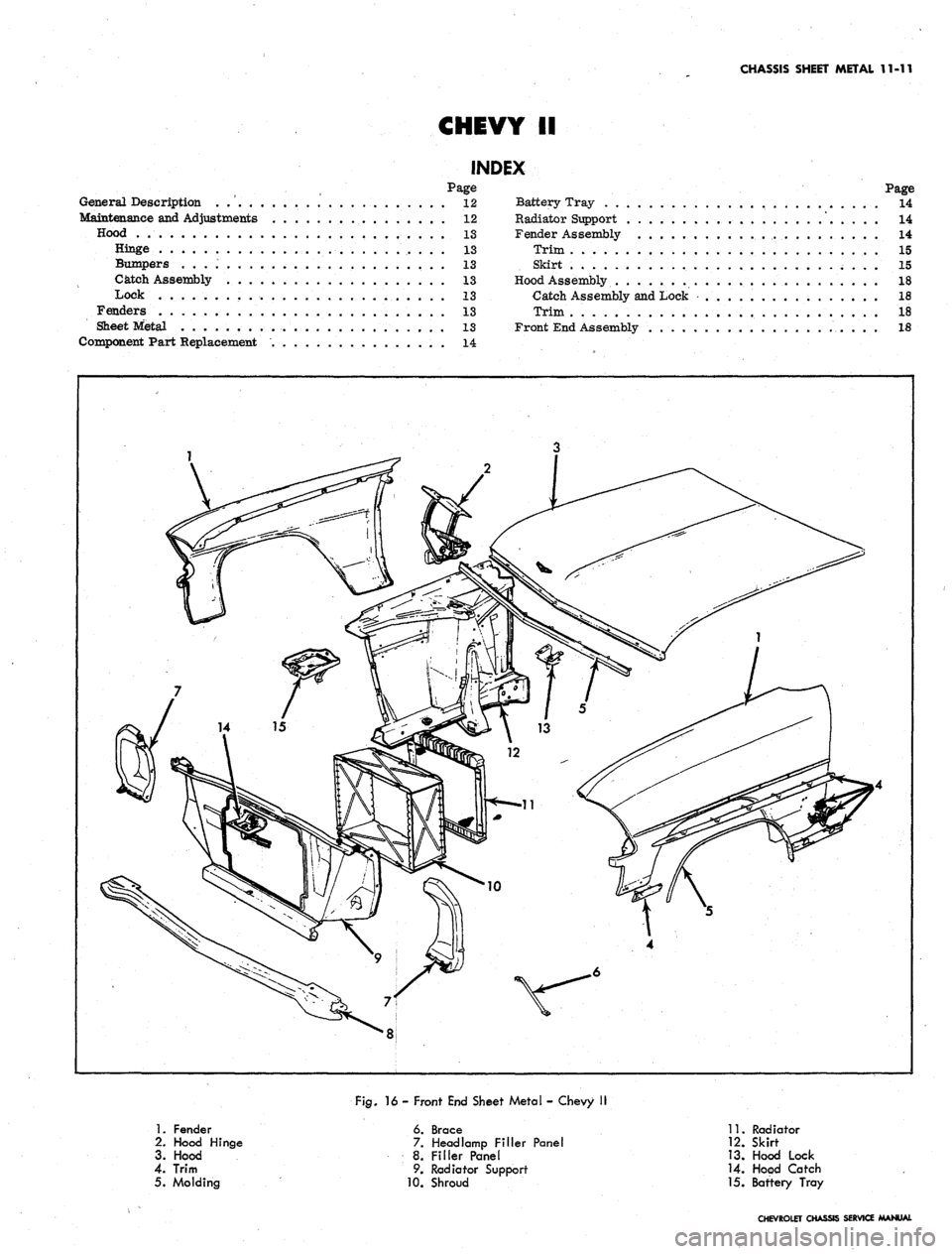
CHASSIS SHEET METAL 11-11
CHEVY II
INDEX
Page
General Description 12
Maintenance and Adjustments 12
Hood ........ 13
Hinge 13
Bumpers 13
Catch Assembly . . . 13
Lock 13
Fenders . 13
Sheet Metal 13
Component Part Replacement 14
Page
Battery Tray 14
Radiator Support 14
Fender Assembly ...................... 14
Trim 15
Skirt 15
Hood Assembly 18
Catch Assembly and Lock • 18
Trim 18
Front End Assembly 18
1.
Fender
2.
Hood Hinge
3. Hood
4.
Trim
5. Molding
Fig.
16 - Front End Sheet Metal - Chevy II
6. Brace
7. Headlamp Filler Panel
8. Filler Panel
9. Radiator Support
10.
Shroud
11.
Radiator
12.
Skirt
13.
Hood Lock
14.
Hood Catch
15.
Baftery Tray
CHEVROLET CHASSIS SERVICE MANUAL
Page 499 of 659
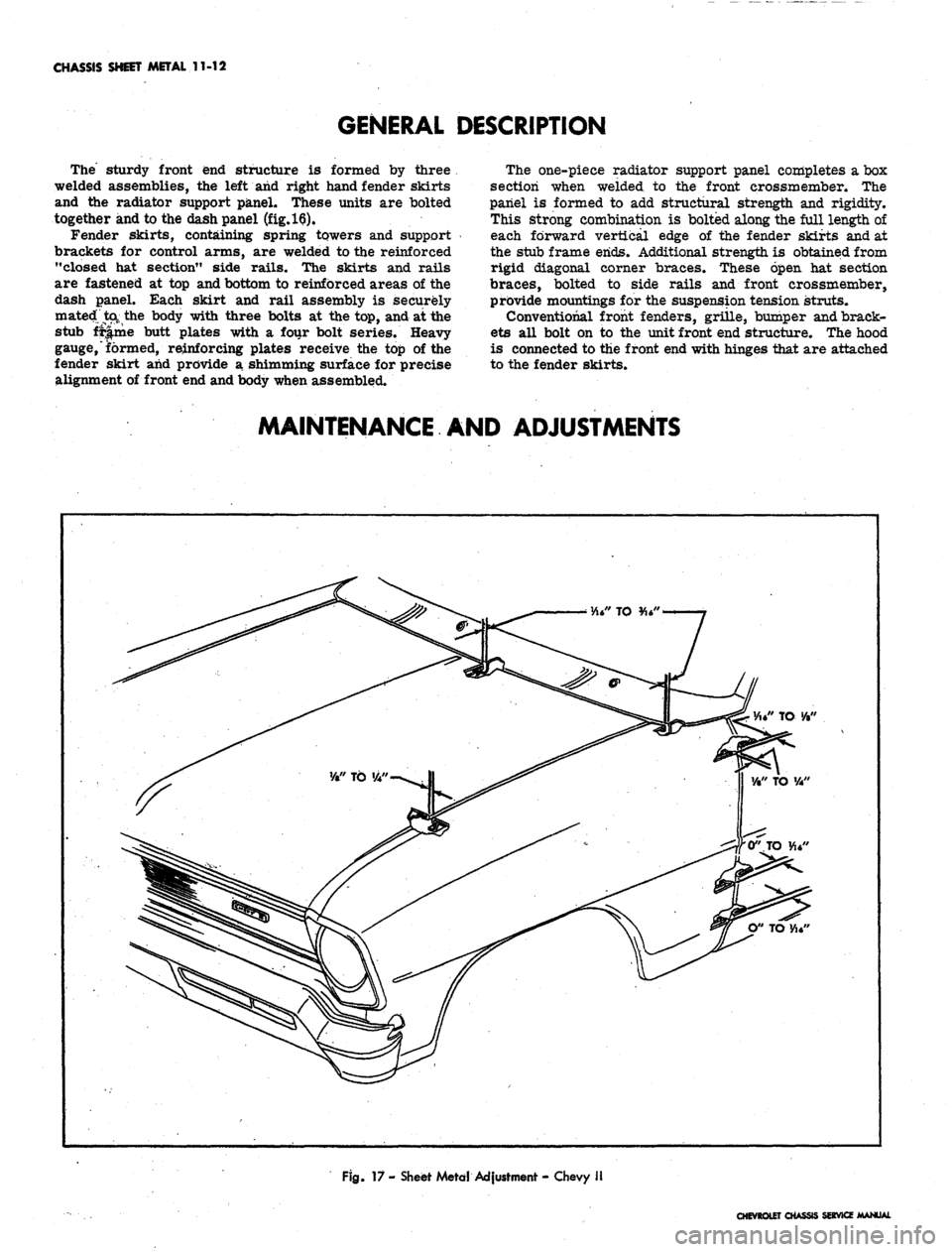
CHASSIS SHEET METAL 11-12
GENERAL DESCRIPTION
The sturdy front end structure is formed by three
welded assemblies, the left and right hand fender skirts
and the radiator support panel. These units are bolted
together and to the dash panel (fig.
16).
Fender skirts, containing spring towers and support
brackets for control arms, are welded to the reinforced
"closed hat section" side rails. The skirts and rails
are fastened at top and bottom to reinforced areas of the
dash panel. Each skirt and rail assembly is securely
mated ta the body with three bolts at the top, and at the
stub fr|.me butt plates with a four bolt series. Heavy
gauge, formed, reinforcing plates receive the top of the
fender skirt and provide a shimming surface for precise
alignment of front end and body when assembled.
The one-piece radiator support panel completes a box
section when welded to the front crossmember. The
panel is formed to add structural strength and rigidity.
This strong combination is bolted along the full length of
each forward vertical edge of the fender skirts and at
the stub frame ends. Additional strength is obtained from
rigid diagonal corner braces. These open hat section
braces, bolted to side rails and front crossmember,
provide mountings for the suspension tension struts.
Conventional front fenders, grille, bumper and brack-
ets all bolt on to the unit front end structure. The hood
is connected to the front end with hinges that are attached
to the fender skirts.
MAINTENANCE AND ADJUSTMENTS
" TO •/•"
Fig.
17 - Sheet Metd Adjustment - Chevy II
CHEVROLET CHASSIS SERVICE MANUAL
Page 500 of 659
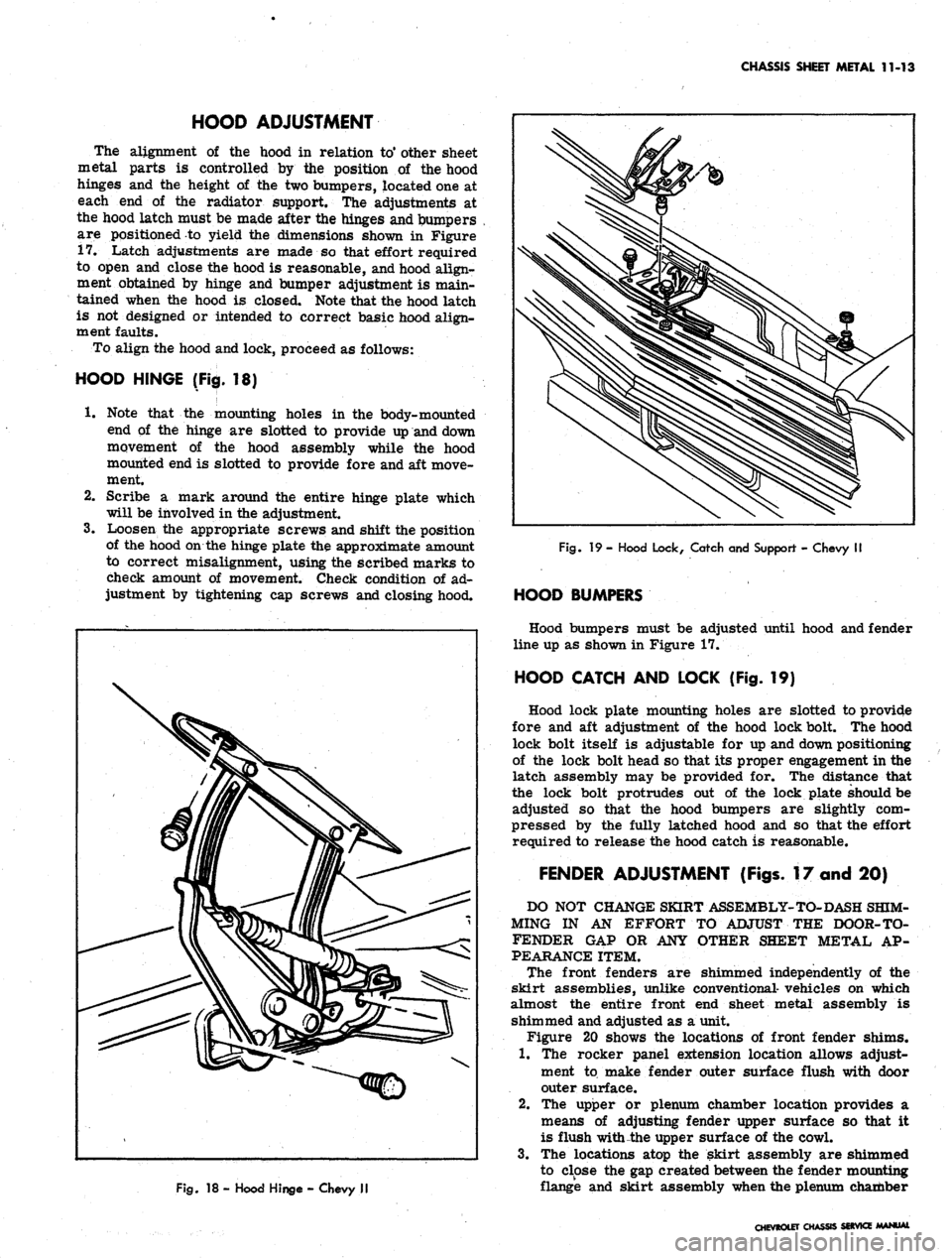
CHASSIS SHEET METAL 11-13
HOOD ADJUSTMENT
The alignment of the hood in relation
to*
other sheet
metal parts is controlled by the position of the hood
hinges and the height of the two bumpers, located one at
each end of the radiator support. The adjustments at
the hood latch must be made after the hinges and bumpers
are positioned to yield the dimensions shown in Figure
17.
Latch adjustments are made so that effort required
to open and close the hood is reasonable, and hood align-
ment obtained by hinge and bumper adjustment is main-
tained when the hood is closed. Note that the hood latch
is not designed or intended to correct basic hood align-
ment faults.
To align the hood and lock, proceed as follows:
HOOD HINGE (Fig. 18)
1.
Note that the mounting holes in the body-mounted
end of the hinge are slotted to provide up and down
movement of the hood assembly while the hood
mounted end is slotted to provide fore and aft move-
ment.
2.
Scribe a mark around the entire hinge plate which
will be involved in the adjustment.
3.
Loosen the appropriate screws and shift the position
of the hood on the hinge plate the approximate amount
to correct misalignment, using the scribed marks to
check amount of movement. Check condition of ad-
justment by tightening cap screws and closing hood.
Fig.
18 - Hood Hinge - Chevy II
Fig.
19 - Hood Lock, Catch and Support - Chevy II
HOOD BUMPERS
Hood bumpers must be adjusted until hood and fender
line up as shown in Figure 17.
HOOD CATCH AND LOCK (Fig. 19)
Hood lock plate mounting holes are slotted to provide
fore and aft adjustment of the hood lock bolt. The hood
lock bolt itself is adjustable for up and down positioning
of the lock bolt head so that its proper engagement in the
latch assembly may be provided for. The distance that
the lock bolt protrudes out of the lock plate should be
adjusted so that the hood bumpers are slightly com-
pressed by the fully latched hood and so that the effort
required to release the hood catch is reasonable.
FENDER ADJUSTMENT (Figs. 17 and 20)
DO NOT CHANGE SKIRT ASSEMBLY-TO-DASH SHIM-
MING IN AN EFFORT TO ADJUST THE DOOR-TO-
FENDER GAP OR ANY OTHER SHEET METAL AP-
PEARANCE ITEM.
The front fenders are shimmed independently of the
skirt assemblies, unlike conventional- vehicles on which
almost the entire front end sheet metal assembly is
shimmed and adjusted as a unit.
Figure 20 shows the locations of front fender shims.
1.
The rocker panel extension location allows adjust-
ment to make fender outer surface flush with door
outer surface.
2.
The upper or plenum chamber location provides a
means of adjusting fender upper surface so that it
is flush with the upper surface of the cowl.
3.
The locations atop the skirt assembly are shimmed
to close the gap created between the fender mounting
flange and skirt assembly when the plenum chamber
CHEVROLET CHASSIS SWVICE MANUAL